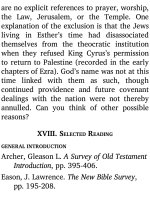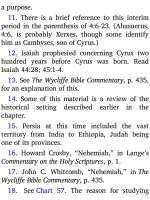Jensens survey of the old testament adam 528
Bạn đang xem bản rút gọn của tài liệu. Xem và tải ngay bản đầy đủ của tài liệu tại đây (79.58 KB, 4 trang )
therefore, was “to clear away the confusion
existing in the minds of the converts by
further de ning the circumstances attending
the Day of the Lord; these are di erent from
the circumstances of the Parousia.”14
6. Read 2:1-12 again and record all that is
written about the man of sin (Antichrist).
Then refer to the section Further Study for
more descriptions of this archenemy of
Christ.
XIV. THEME, KEY WORDS AND VERSES FOR 2
THESSALONIANS
Compose a theme for 2 Thessalonians.
This should center on the main subject of
the epistle.
Make a list of key words and verses of the
letter, as you observed these in your survey
studies. Compare your list with what is
recorded on Chart 95.
XV. APPLICATIONS FROM 2 THESSALONIANS
This second letter is lled with truths
applicable to the Christian life. For example,
what is taught about victorious Christian
living in 3:1-5, and about the disciplined life
in 3:6-15? Go through the three chapters
and list the applications you see.
XVI. REVIEW QUESTIONS ON 2 THESSALONIANS
1. Does Paul identify himself by name in 2
Thessalonians?
2. When did he write the second letter?
3. What were Paul’s reasons for writing?
4. Compare the two letters in five ways.
5. Compare the rapture and the
revelation.
Complete the two phrases:
BEFORE THE RAPTURE: _____________________
BEFORE THE REVELATION: _________________
6. Compare the lengths of the two letters.
7. Identify a title for each.
8. What is the key point of 2
Thessalonians, regarding Christ’s second
coming?
9. Identify the contents of each chapter.
10. Where does Paul write most about the
Antichrist (man of sin)?
XVII. FURTHER STUDY OF 2 THESSALONIANS
Because the Antichrist is a main character
of 2 Thessalonians 2, it will be very helpful
for you to read other passages of Scripture
about him. (The Thessalonians knew about
him from the Old Testament and from Paul’s
earlier instruction [2:5-6].) Read the
following: Ezekiel 38-39; Daniel 7:8, 20;
8:24;
11:28—12:3;
Zechariah
12-14;
Matthew 24:15; 1 John 2:18, 22; 4:3; 2 John
7; Revelation 13:1-10; 17:8.
Various names by which this Antichrist is
identi ed in Scripture are the little horn
(Dan. 7:8; 8:9), the prince that shall come
(Dan. 9:26), the willful king (Dan. 11:36),
the man of lawlessness (sin) (2 Thess. 2:3),
the son of destruction (perdition) (2 Thess.
2:3), that lawless (wicked) one (2 Thess.
2:8), antichrist (1 John 2:18), the beast out
of the sea (Rev. 13:1-10).
John wrote about many antichrists in the
world, but singled out the Antichrist (1 John
2:18). This Antichrist is a real person, an
emissary of Satan, the personi cation of evil,
and the culmination of all that is opposed to
God.
Chart 96 shows the temporary reign of
Antichrist during the Tribulation period, as
it is related to the two phases of Christ’s









